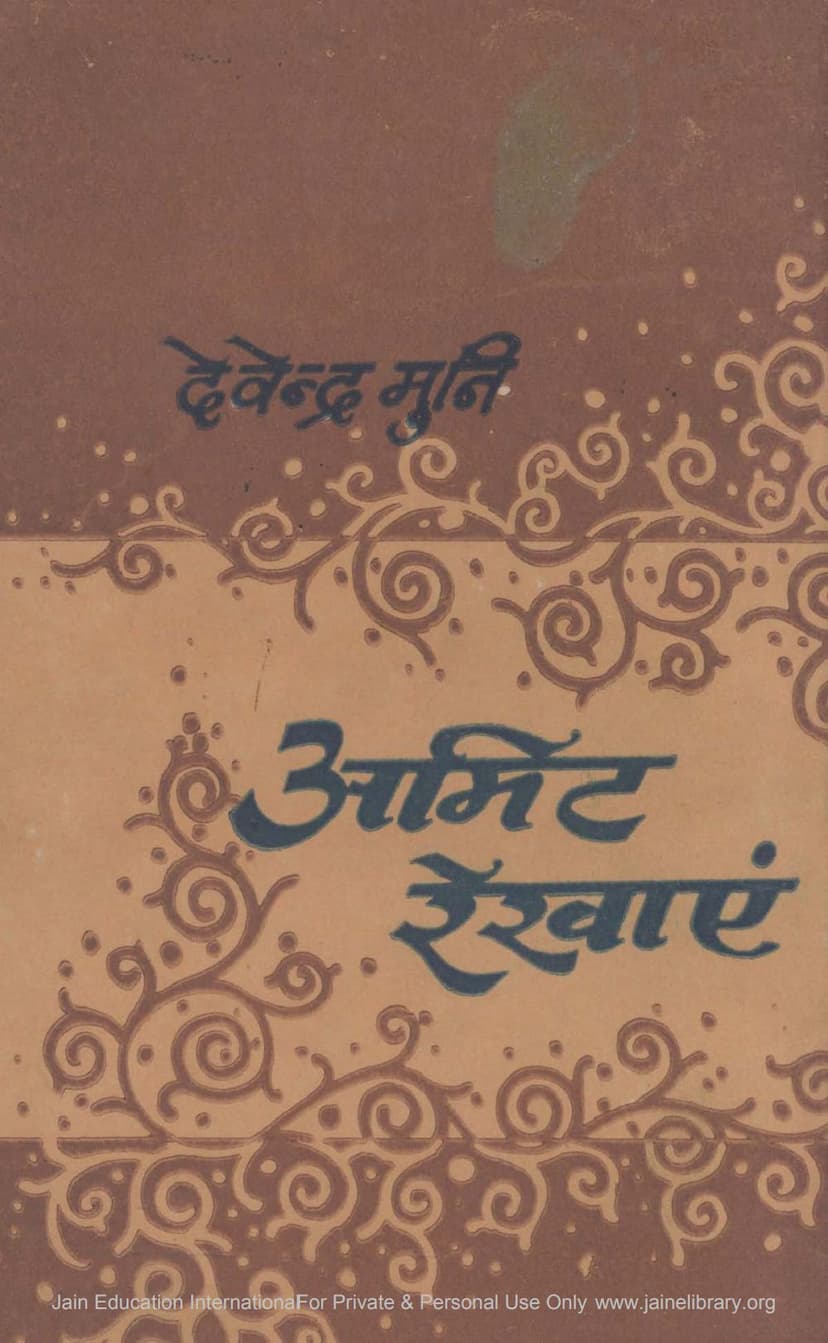Amit Rekhaye
Added to library: September 1, 2025

Summary
This document is a collection of Jain stories titled "Amit Rekhaye" (Ambit Rekhaye), authored by Devendramuni. It was published by Shri Tarak Guru Jain Granthalay in 1973.
The book is dedicated to the author's mother, Mahasati Shri Prabhavati Ji M., who instilled in him a sense of detachment and narrated historical and religious stories in his childhood.
Author's Note: Devendramuni emphasizes the power and beauty of storytelling, calling it the "best and most enjoyable literature." He quotes Richard Burton, who stated that storytelling is the oldest human endeavor, starting when humans learned to walk. The author also discusses various definitions of storytelling by literary figures like Edgar Allan Poe and Jack London, highlighting the importance of emotional appeal, unity of effect, and character development.
He classifies stories based on style (descriptive, dialogue-based, autobiographical, diary-based, letter-based) and theme (love, historical, detective, humorous, satirical, ideal, psychological). The stories in "Amit Rekhaye" are primarily historical and ideal, with some written in 1973 and others in 1963.
The author expresses gratitude to his guru, Shri Pushkar Muniji M., for his blessings and to 'Saras' Ji for the beautiful printing of the book.
Publisher's Note: The publishers express joy in presenting "Amit Rekhaye" to their readers. They highlight Devendramuni's prolific writing career, with over forty books in various genres. They describe the historical and ideal stories in this book as inspirational and thought-provoking. The publishers also announce upcoming works, including "Mahavir Yug Ki Pratinidh Kahaniyan" (Representative Stories of Mahavir's Era) and a research thesis on Mahavir's life. They extend their thanks to donors who supported the publication.
Table of Contents: The book contains a collection of 28 stories, including:
- Sachcha Kalakar (The True Artist)
- Acharya Sthoolbhadra (Acharya Sthoolbhadra)
- Mahayagya (The Great Sacrifice)
- Kheeza aur Reeza (Irritation and Affection)
- Bhakt Raidas (Devotee Raidas)
- Rajkumar Ka Chaturya (The Prince's Cunning)
- Vijay Ka Rahasya (The Secret of Victory)
- Pratibha Ki Pratibha (The Genius of Genius)
- Sandeh Se Mukti (Freedom from Doubt)
- Suyogya Putra (The Worthy Son)
- Amar Phal (The Immortal Fruit)
- Samasya Ka Samadhan (The Solution to the Problem)
- Anmol Jeevan : Koudi Ka Mol (A Precious Life: Worth of a Cowrie)
- Kya Manav Garib Hai? (Is Man Poor?)
- Adarsh Bhavna (Ideal Sentiment)
- Anand Kahan? (Where is Bliss?)
- Kalakar Ki Alochana (Criticism of the Artist)
- Badshah Ki Ramayana (The King's Ramayana)
- Pariksha (The Test)
- Kaliyug Ka Bodh (Understanding of the Kali Yuga)
- Prithak-Prithak Saja (Separate Punishments)
- Kala Ka Devta (God of Art)
- Paavan Vrat (The Sacred Vow)
- Mool Ka Suchi Patra (List of Roots - this seems to be a misprint in the table of contents, it might be a placeholder or a different story)
- Parivrat Aur Samrat (The Ascetic and the Emperor)
- Kshama Murti (Embodiment of Forgiveness)
- Karuna Murti (Embodiment of Compassion)
- Shishyon Ki Pariksha (The Test of the Disciples)
Summary of Some Key Stories:
- Sachcha Kalakar (The True Artist): This story contrasts the artistic skills of a charioteer and a dancer with the spiritual discipline of Acharya Sthoolbhadra. The charioteer, impressed by a dancer's skill, tries to impress her with his own prowess, but she demonstrates a greater mastery. She then extols Sthoolbhadra's virtue in remaining pure despite being in the company of a beautiful woman for twelve years, redefining "true art" as inner strength and self-control.
- Acharya Sthoolbhadra: This narrative details the significant role of Acharya Sthoolbhadra in preserving Jain scriptures during a severe famine and its aftermath. It highlights his dedication to learning the "Drishtivada" from Acharya Bhadrabahuji, who was in Nepal. The story emphasizes Sthoolbhadra's perseverance in studying under challenging conditions and his eventual mastery of the scriptures, culminating in his becoming the successor to Acharya Bhadrabahuji.
- Mahayagya (The Great Sacrifice): This story presents a dialogue between a king's grand Ashwamedha Yajna and a much humbler act of charity by a poor Brahmin family. A magical mongoose appears, with half its body golden, stating that the Brahmin's act of offering a single handful of flour to a guest was far greater than the king's immense expenditure. The mongoose reveals its golden half is a result of that selfless act, illustrating that true greatness lies in genuine generosity, not in grand displays of wealth.
- Bhakt Raidas (Devotee Raidas): This story showcases the devotion and integrity of the cobbler-saint Raidas. When a proud Brahmin asks Raidas to return a jewel gifted by the river Ganges, Raidas, despite being a humble cobbler, manages to produce the jewel by praying to the river, demonstrating that true devotion and divine grace transcend social status.
- Suyogya Putra (The Worthy Son): This parable highlights the importance of filial duty and discernment. A son, influenced by his manipulative wife, is about to bury his elderly father alive. However, his young son, witnessing this, digs a second grave for his father, stating he will do the same when his father is old. This act of foresight and implicit criticism awakens the son to his cruel intentions, leading him to abandon the plan and rectify his wife's malicious influence.
The book generally focuses on ethical teachings, exemplary lives of Jain figures, and moral lessons presented through engaging narratives.